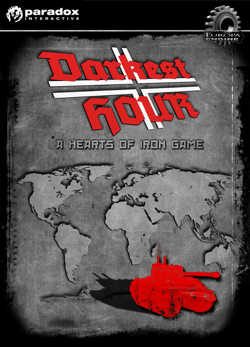Darkest Hour: A Hearts of Iron Game
| Darkest Hour: A Hearts of Iron Game | |
|---|---|
 | |
| Developer(s) | Darkest Hour Team |
| Publisher(s) | Paradox Interactive |
| Engine | Europa Engine |
| Platform(s) | Microsoft Windows |
| Release date(s) | 5 April 2011[1] |
| Genre(s) | Real-time grand strategy |
| Mode(s) | Single-player, multiplayer |
Darkest Hour: A Hearts of Iron Game is a grand strategy wargame that is based on Paradox Interactive's Europa engine.
It allows the player to take control of and manage nearly any nation-state during the 1914–1964 timeframe including its political, diplomatic, espionage, economic, military, and technological aspects. The game was released on 5 April 2011.[1]
Description
Darkest Hour is, at its core, an evolution of Hearts of Iron II: Armageddon.[2] This has been considered crucial by the development team to make it easy to port community-made modifications from Hearts of Iron II to Darkest Hour.[2] Moreover, the most important changes to the engines have been added as mods to the core game, with the name Darkest Hour Light and Darkest Hour Full:[2]
- Darkest Hour (core game): this version is focused on compatibility with Hearts of Iron 2 Armageddon and all mods available for it. The number of changed files has been kept as low as possible and all new options are disabled or set as close as possible to the original settings.
- Darkest Hour Light: this version is available as a mod with only a few changes from HOI2, but nearly all new features are enabled.
- Darkest Hour Full: this version is available as a mod without any compatibility with HOI2 and implements or reworks many new features, the most visible difference being the new map and research system.
Gameplay
Darkest Hour Full provides different grand campaign scenarios (where it is possible to choose any of the nations involved) or battlescenarios (focused on single theaters of operations, with only a few nations involved and playable).[2]
The scenarios are:
- 1914 The Great War (starting on June 27, 1914)
- 1936 The Road to Another War (starting on January 1, 1936)
The player can build land divisions, aircraft wings, and naval ships/fleets, and combine these into corps and armies. The player also has the ability to control the appointment of military leaders of land, air and naval units as well as to control the appointment of individual government ministers and military commanders in key General Staff positions. The player can declare war, make alliances, claim and annex territories. The player can also alter the social and economic policies of their nation using sliders, such as democratic versus authoritarian, free market versus central planning and so on. Moving the sliders would result in different bonuses and penalties, allowing for a range of choices and strategies. Technological research is also controlled by the player. All this is on a global scale, with the player simultaneously dealing and interacting with nations across the world. The game can be paused at any point.
The game provides a launcher that allows the player to change its settings (like resolution, language, etc.) and eventually choose a mod to run on top of it.[2]
The 1.02 patch, released on November 11, 2011[3] added four new grand campaign scenarios and new functionalities (infantry units can now have two brigades and it is possible to upgrade a unit to a different model, for example a simple infantry unit can be upgraded to a motorized unit). The four new scenarios are:
- 1933 Day of Decision (starting on March 4, 1933)
- 1940 Burning Europe (starting on May 10, 1940)
- 1941 Awakening the Giant (starting on June 22, 1941)
- 1942 Enemy at the Gate (starting on November 22, 1942)
With the 1.03 patch,[4] further scenarios were added:
- 1939 Invasion of Poland
- 1943 Allied Invasion of Sicily
- 1944 Allied Landing in Normandy
- 1945 Battle of the Bulge
Furthermore, two battle scenarios were added. In these, the player can choose between a small number of nations. The battle scenarios focus on specific battles or wars:
- 1904 Russo-Japanese War
- 1939 Invasion of Poland
Community mods
It had been confirmed that many mods designed for Hearts of Iron II: Armageddon would also be converted to Darkest Hour. Most popular of these mods include Kaiserreich (alternate history where Central Powers won World War I), the Fallout Mod Fallout's Doomsday (set in the world of Fallout games), and Mod33 (rework of the game, beginning in 1933). Kaiserreich was released the same day as the game.[5] Mod33 was released on 27 August 2011.
In September 2011, the mod Arms, Armistice and Revolutions (AAR) has been made available, which links the 1914 scenario to the classical 1933/1936 grand campaign. There are plans to integrate the mod into the main Darkest Hour game in future patches. AAR is development as an open project, thus players are free to participate in development.
Expansion packs
The Iron Cross expansion for Hearts of Iron II and Arsenal of Democracy: A Hearts of Iron Game is also compatible with Darkest Hour.[6]
Development
Darkest Hour was first announced on September 14, 2010 by Paradox Interactive.[7] The game became possible due to Paradox Interactive licensing the Europa engine to independent developers.[8]
See also
- Wargame (video games)
- Chronology of grand strategy video games
- List of Paradox Interactive games
- List of PC games
References
- 1 2 "Darkest Hour: A Hearts of Iron Game Released" (Press release). Paradox Interactive. April 5, 2011. Retrieved April 5, 2011.
- 1 2 3 4 5 "First Developer's Diary". 2010-09-14.
- ↑ http://forum.paradoxplaza.com/forum/showthread.php?569802-Darkest-Hour-Patch-1.02-Hot-fixes
- ↑ http://forum.paradoxplaza.com/forum/showthread.php?635575-Darkest-Hour-Patch-1.03-RC1-Hot-fixes
- ↑ http://forum.paradoxplaza.com/forum/showthread.php?529638-Kaiserreich-for-DH-1.0-released!
- ↑ http://forum.paradoxplaza.com/forum/showthread.php?t=499365
- ↑ "Paradox Interactive announce Iron Cross and Darkest Hour". Paradox Interactive. 2010-09-14.
- ↑ Licensing Europa Engine, Paradox Plaza